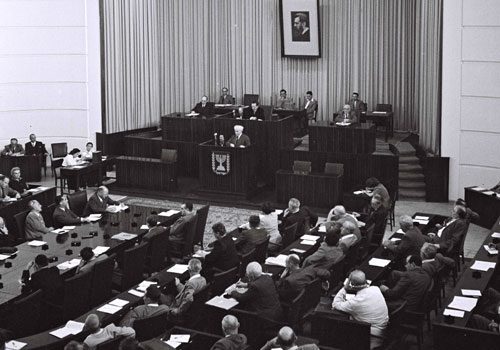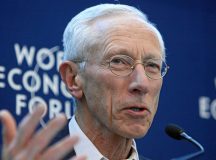Routinely berated for producing weak governments beholden to minorities, Israel’s electoral system actually gives all a voice and keeps all groups on the inside. We should exercise extreme caution in changing it.
The Israeli electoral system has never wanted for critics or well-intentioned reformers, yet its basic contours have remained remarkably unchanged since the first general election in 1949. Unchanged and unloved, it is also vastly underappreciated. Its quirks and supposed deficiencies have – by historical accident rather than by design – made an enormous contribution to Israeli political stability and to the normalisation of democracy in a society that by any comparative reckoning should never have had it so good.
Naysayers, particularly from the English-speaking world, have accused Israel’s proportional representation system of breeding constant instability and empowering fringe elements and extremists, while an undercurrent of domestic discourse pines for ‘strong leadership’ that is not always looking over its shoulder to please coalition partners.
Mythical vices
It is a matter of nearly universal consensus among critics that the electoral threshold for the Knesset is simply too low. It stands today at two percent, having been raised twice already (from one percent and one and a half percent). If we were to judge by the indignation this supposedly low threshold inspires, we might expect to see a Knesset with lots of tiny parties just squeaking past the two percent with only two seats. But this Knesset has none. The two smallest parties to enter the Seventeenth Knesset in 2009 both had three seats, and the same was true in the Eighteenth. Not a single party in either Knesset was at the threshold of two seats, and, for that matter, no parties missed entering the Knesset for having fallen just below the threshold either. The threshold simply wasn’t relevant. Nor is Israel’s low threshold particularly unique. A threshold of four percent or five percent is common in many democracies, but of those, some, like Poland and Romania, make exceptions for national-ethnic minorities, and others, like Germany or New Zealand, do not apply the threshold to parties that win direct mandates in regional districts. Mature democracies in Finland and the Netherlands, among others, do just fine with no threshold. Only Turkey imposes a high ten percent threshold.
To be sure, there are quite a few parties in the Knesset, though the number is far from extraordinary when compared to some European parliaments. Even the UK, the most radically anti-proportional parliament in Europe, returned ten parties after the most recent general election (and, lest anyone think that was a fluke, eleven in the one before that). In Israel, the number of parties returned at each recent election has held steady at around twelve, and this number, believe it or not, is not a bad reflection of the existing political cleavages in Israel’s very diverse and deeply divided political society. Israel’s real ‘problem’ is not the proliferation of tiny parties but the growth of medium-sized parties and, in the last two decades, the decline of large ones. In all of Israel’s first thirteen general elections (out of eighteen so far), at least one party was returned to Parliament with 40 or more seats (out of 120). In the Seventh and Eighth Knessets, one party even exceeded 50, and in the Tenth and Eleventh, two parties topped 40. Since 1996, no party has come even close, and three of the last four Knessets have been elected without any party even crossing 30 seats. Is this because of creeping inroads by small parties screeching across a low threshold? Not at all. In fact, at the peak performance of the two large parties in the 1980s, there were more parties in the Knesset than today (15 rather than 12).
Election results for the Knesset have evolved in three distinct phases. The first eight elections (1949-1973) returned Knessets with one large party and its satellites and opponents. The next five (1977-1992) gave us two large parties and ten or more small ones. And the most recent five (1996-2009) have left us with a smattering of medium-sized parties. The action, as it were, has simply not been anywhere near the threshold.
The existing parties more or less faithfully represent the ethnic, religious and ideological cleavages in Israeli politics. Raising the threshold much higher than it is today would not push out the cranks. It will, rather, leave entire constituencies unrepresented by their own parties, with no real leverage over larger parties to broaden their bases either. Do we really want to see a consolidated Arab bloc pandering only to its Islamist element? A joint ultra-Orthodox list with no issue binding it together but draft-dodging and welfare entitlement? These would be the comparatively optimistic scenarios with a higher threshold. The more likely outcome would be a complete exit from democratic politics by precisely those groups whose connection to the state’s ‘rules of the game’ is already tenuous at best.
The kinds of parties ordinarily believed to be swatted away by higher thresholds exist more in people’s imaginations or exaggerated memories than in actual Knessets of recent years. Single-issue parties rarely cross the threshold and never survive more than one Knesset anyway. The vanity list, a faction built around a notable figure and one or two hangers-on, has largely disappeared from the Israeli electoral scene. These parties were almost always led by prickly former generals who were either frustrated and bewildered by their less than meteoric rise to the top of an established party, or who left an established party in a huff over some principle which no one can remember a week or two after the split. They have faded from the scene as the gloss of generals has faded from Israeli political consciousness, and although the next parliamentary election may see a new vanity list cross the threshold under Ehud Barak, I would not place any money on that outcome. The Israeli public of 2013 is too mature for this kind of thing, and Barak’s ambitions are too large for mere vanity lists.
Of course, the scourge of tiny parties is not the only thing critics of Israel’s proportional representation find fault with. We are commonly told that it is nearly impossible to put together a coherent government here, though in fact every election – even the most seemingly indecisive ones (1984, 2009) – have led to a government being formed within the allotted 45 days. This is in stark contrast to situations that routinely emerge in Belgium where months pass between an election and a coalition. Even Britain had to go to the polls twice in 1974 to get a manageable governing majority.
Minority governments have also been a rarity in Israel, though they are currently in power in both Denmark and the Netherlands. The longest-lived minority coalition, from 1993 to 1996, rested on the anomaly of Arab parties remaining outside a government they supported. It is safe to assume that if there is ever another left-wing majority in the Knesset, this anomaly will be a thing of the past.
If the threshold is not really ushering in tiny parties, governing coalitions are relatively easy to form, and minority governments are rare and not genuinely minorities anyway, then what is left on the charge sheet?
A common complaint is that elections are too frequent and parliaments rarely last their full terms. The latter is true of the Knesset, but it is equally true of nearly every parliament. In the Knesset’s first sixty years, there were exactly seventeen Parliaments, an average duration of three and a half years – not bad considering a full term is four years. Even this statistic leaves out the good part of the story, as it includes in it two very short-lived Knessets from the state’s early days. In the last fifty years, no Knesset has sat for less than three years.
But are not Israel’s governing coalitions unstable? Are not prime ministers always struggling to hold on to precarious majorities? The short answer is no. The long answer is no, too, actually. Again, it helps to separate out the first five Knessets – two of which lasted only two years, and one of which featured no fewer than four governing coalitions – from the twelve subsequent Knessets, each of which has served between three and four years and none of which had more than one reshuffle. In fact, even the numbers for the first five Knessets hide a certain stability – all were dominated by the same man, David Ben-Gurion, who was Prime Minister for the duration of all five, save for two years at the end of the Second Knesset and two years at the end of the Fifth.
Governments are unstable, we are told, and Prime Ministers are always struggling for survival rather than making long-term decisions. Perhaps they are not thinking for the long-term, but parliamentary survival cannot take all the blame. The total number of governments that have fallen by no-confidence votes in all of Israeli history is one (in 1990), and if it were zero, I would argue that that is a defect.
The Knesset is a noisy and chaotic place, and the noise and chaos of people who do not agree with me tends to be particularly annoying. To me. But that is the point, isn’t it? Even after 64 years of statehood, it remains the only forum in the entire country where Israelis of all kinds actually have to listen to each other. Even when the outcome of a decision is easily known in advance, it still must go through a trial by discussion according to formalistic procedures that gives it a status no other public decision has. No other Israeli institution does this – not the army, which does not draft Arabs or ultra-Orthodox, not the High Court and certainly not the media.
Hidden virtues
A society as deeply divided as Israel is – across race, religion, ideology – with such a high tolerance for violence and such a broad familiarity with weapons, should have by all comparative measures long ago descended into civil war. Nearly every other newly independent post-1945 state certainly did.
Political violence has not been a completely absent feature of Israeli political life (the assassination of Prime Minister Yitzhak Rabin in November 1995 and the shooting of 13 Israeli-Arab protesters in October 2000 are two recent examples), but the few actual outbursts are memorable precisely for being so rare; it is generally experienced more as a menacing threat in potentia, a foreboding presence sublimated beneath the surface, for example during the 1981 general election campaign.
How did Israel manage to avoid the fate of nearly every other post-colonial state and prevent itself descending into civil war? At the moment of statehood, two immediate factors stood out. First, there was an enormous imbalance between the potential factions, unlike, say, Ireland in 1922 where those that were willing to accept partition and those that insisted that anything less than the entire island was a betrayal were roughly even. Second, Israel’s national liberation, unlike so many other post-colonial births, was not just the end of one foreign domination; it was also the most threatening moment of another. Having to fend off a combined Arab invasion united disparate pre-statehood factions as no ideology could have.
Beyond 1948 though, there are two more factors that have precluded a descent into internal fighting. The first is the civic religion which was constructed in Israel and known by the untranslatable Hebrew word mamlakhtiut. This austere republicanism, created almost entirely in the image of one man, David Ben-Gurion, never demanded from its citizens that they put aside their own communal or ideological attachments, but only that those always took second place to the institutions and interests of the state and its value as an end, rather than a means.
But by far the biggest institutional keeper of the peace, even in the face of the decline of the old republicanism – no, especially in the face of its decline – has been the very broad and inclusive basis of representation in the Knesset. The payoffs for marginal groups to stay in the legitimate game of Israeli domestic democratic politics is often quite small (and why should it be otherwise?), but it has always, thus far at least, been big enough to keep nearly everyone inside arguing rather than outside shooting. The only significant election boycott was in 2001 by the Arab sector in a special election for the Prime Minister only – a one-of-a-kind event that was made possible by the now defunct Direct Election Law.
The stakes were low – Ariel Sharon was due to win by a landslide with or without Arab participation – and no Knesset seats were up for grabs. Very few of this community’s grievances were answered in the two years that ensued, yet when the Knesset was dissolved in 2003 there was no recurrence of the boycott. The risks of an Arab boycott are too high, and the kind of Knesset that could be elected without their votes would make a return from such a boycott in a subsequent election exceedingly difficult and costly. It would be a breaking point for Israeli democracy and, while the tacit, implicit threat might yield modest results, its actual use is saved only for extreme circumstances.
The Arab minority is not the only social group in Israel with a problematic relationship with the state and its institutions. Other sectors have their own resentments and parochial agendas, but having to present them in speech acts and public acts of bargaining, and having to phrase them – however hypocritically and piously – in terms of the general interest, has a moderating influence on all parties. The few policy treats the establishment throws at marginalised groups have been enough to keep the talking game going.
Bringing as many voices in as possible was the animating idea behind the electoral system the first time it was used in 1949. What is largely forgotten was that this was for a constituent assembly, not a regular Parliament. It was only once the assembly met that it retroactively declared itself the First Knesset and put off the business of writing a constitution indefinitely (and, in my opinion, wisely). A different electoral system would have had to surmount logistical hurdles and needed some sort of constitutive moment to legitimise itself, so the status quo, which has done so much to preserve the internal peace, has survived and thrived, despite all the scorn heaped upon it. If there was ever any hope that Israel might introduce an element of geographic representation into its electoral rules, the settlement of civilian populations in territories occupied but not annexed rendered that nearly impossible. Drawing constituency boundaries would require an honest discussion of the state’s boundaries and risk highlighting the anomalies of Israeli democracy for the Israelis who have made their home beyond the frontier.
Learning by example?
One explanation is the dominance in Israeli political discourse of a referent that could not be any less relevant to Israeli democracy. Two centuries of American constitutional self-governance leaves much to admire and study, but very little of it will be useful to anyone trying to tackle the problems of Israel’s democracy. For reasons that are obvious, but which have nothing to do with institutional or constitutional questions, the American example – or, more accurately, the American example as imagined by partially informed outside observers – looms very large in the Israeli imagination. This is largely due to its availability and familiarity, but not to its applicability.
The latest round of legislative elections in Sweden or Switzerland do not excite the news-consuming public in Israel in quite the way that American mid-term elections understandably do. As a result, Israelis often have a familiarity with the workings of American democracy and governance far beyond that which they have for any other country. It becomes the most readily available source for seeing politics ‘done differently’ – a foil for Israeli politics in the eyes of so many Israelis.
This is understandable but regrettable, because we are now learning from the experience of the one democracy that resembles Israel the least. To see this, it might help to list some of the salient structural features of Israeli democracy and come to grips with the kind of problems Israel’s electoral method needs to provide solutions for.
Israeli democracy is characterised first by its (1) moderate size (between 5 and 20 million citizens) – not a micro-state or one large metropolis surrounded by hinterland, nor an enormous country with tens or hundreds of millions stretching over a gigantic land mass. It is further characterised by its (2) central, unitary government (rather than a federal system) and lack of natural geographic divisions, which might lend themselves to a federal administration. Its national identity has been an enormously successful project of (3) linguistic and cultural consolidation across diverse immigrant groups, rather than a projection of an old identity (or an image of one) on small numbers of newcomers. Its national ethos, though retaining many civic, republican and ideological aspects, has a strong affinity to a particular (4) religious tradition; religious symbols are part of its flag and national narrative, and they are deeply meaningful for most of the population, even the majority that are not actively practising.
It has a large (5) ethnic-linguistic minority, with its own collective memory and political traditions, and its own affinities with nations outside its boundaries; this minority is native to the land and not just an immigrant group in a suspended state of assimilation. And, as a mirror image to that, the majority ethnic group has (6) large diasporas in other countries throughout the world. It also has (7) unanswered territorial ambitions of ambiguous and declining importance, and it retains a (8) large extra-territorial settler population with full voting rights in domestic elections in a territory where the non-settler majority enjoys no such right and no realistic hope or desire of gaining full citizenship.
Of lesser importance, though still relevant, is Israel’s geostrategic position. It is (9) surrounded, economically as well as politically, by much less developed neighbours whose attitudes range from quite to very hostile. There is no plausible scenario in which the gaps in standards of living or quality of life between Israel and any of its neighbours will close; nor is there much more hope that the hostility will attenuate dramatically in our lifetimes. It (10) does not have borders that are both internationally recognised and domestically accepted. And it has for its entire history been (11) firmly in the pro-American camp of the post-1945 international order.
Of all these eleven characteristics of Israeli democracy, only (8) is unique. To the best of my knowledge, nothing like it has existed in any other advanced state since the end of the Portuguese presence in Mozambique and the French presence in Algeria. What is astonishing about the remaining ten items on this list is how many are shared with other advanced democracies – and how few are relevant for US democracy, except for (3) and, trivially, (11). On the other hand, countries as diverse as Ireland, Belgium, the Netherlands, Denmark, Singapore, South Korea, and Taiwan all share between five and eight of the traits enumerated above. Each has carved a different path to its present democratic arrangements, with all the expected burdens of history and accident. Israelis would do well to learn from both the successes and failures of those countries’ institutional arrangements long before trying to foist upon their own country a provincially misunderstood American method.
Too much viewing of The West Wing could leave anyone longing for a presidential system. But we easily forget how little power over legislation an American president has at the federal level, and that most law making occurs at the state level where he has none. No such balance is plausible in the Israeli context, where the predictable result of a strong president with no one to report to would more closely resemble presidential experiments of other small and young democracies – intrigue, excess, attempts by the winner to shut out the loser and a hunt by whoever is shut out for forums outside the constitutional order to press their cause.
Israeli parliamentarism has served its people well, and we should exercise extreme caution in changing it. Not that I don’t have my own wish list (at least 60 more MKs, hopefully some elected regionally). But I would rather keep the current system than risk letting today’s winners entrench their victories with an imagined efficiency that solves problems we do not have and erases the unique benefits of a system that has managed to give everyone a voice, let no one dominate and keep everyone on the inside. The stakes on the outside are just too high.






































One of the best and detailed narratives of Israel’s electoral system that you will ever read. A superb analysis.